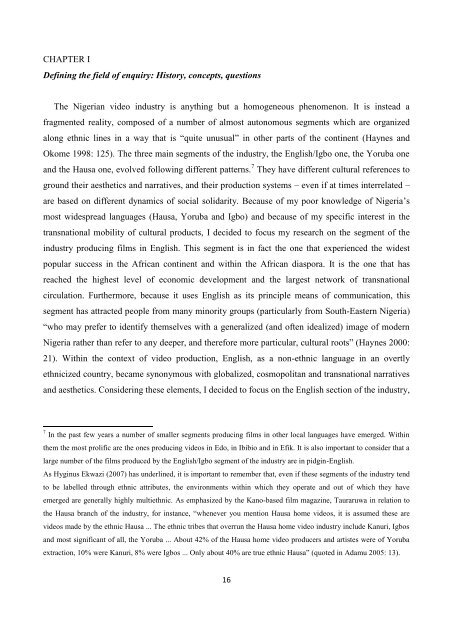You also want an ePaper? Increase the reach of your titles
YUMPU automatically turns print PDFs into web optimized ePapers that Google loves.
CHAPTER IDefining the field of enquiry: History, concepts, questionsThe Nigerian video industry is anything but a homogeneous phenomenon. It is instead afragmented reality, composed of a number of almost autonomous segments which are organizedalong ethnic lines in a way that is “quite unusual” in other parts of the continent (Haynes andOkome 1998: 125). The three main segments of the industry, the English/Igbo one, the Yoruba oneand the Hausa one, evolved following different patterns. 7 They have different cultural references toground their aesthetics and narratives, and their production systems – even if at times interrelated –are based on different dynamics of social solidarity. Because of my poor knowledge of Nigeria’smost widespread languages (Hausa, Yoruba and Igbo) and because of my specific interest in thetransnational mobility of cultural products, I decided to focus my research on the segment of theindustry producing films in English. This segment is in fact the one that experienced the widestpopular success in the African continent and within the African diaspora. It is the one that hasreached the highest level of economic development and the largest network of transnationalcirculation. Furthermore, because it uses English as its principle means of communication, thissegment has attracted people from many minority groups (particularly from South-Eastern Nigeria)“who may prefer to identify themselves with a generalized (and often idealized) image of modernNigeria rather than refer to any deeper, and therefore more particular, cultural roots” (Haynes 2000:21). Within the context of video production, English, as a non-ethnic language in an overtlyethnicized country, became synonymous with globalized, cosmopolitan and transnational narrativesand aesthetics. Considering these elements, I decided to focus on the English section of the industry,7 In the past few years a number of smaller segments producing films in other local languages have emerged. Withinthem the most prolific are the ones producing videos in Edo, in Ibibio and in Efik. It is also important to consider that alarge number of the films produced by the English/Igbo segment of the industry are in pidgin-English.As Hyginus Ekwazi (2007) has underlined, it is important to remember that, even if these segments of the industry tendto be labelled through ethnic attributes, the environments within which they operate and out of which they haveemerged are generally highly multiethnic. As emphasized by the Kano-based film magazine, Tauraruwa in relation tothe Hausa branch of the industry, for instance, “whenever you mention Hausa home videos, it is assumed these arevideos made by the ethnic Hausa ... The ethnic tribes that overrun the Hausa home video industry include Kanuri, Igbosand most significant of all, the Yoruba ... About 42% of the Hausa home video producers and artistes were of Yorubaextraction, 10% were Kanuri, 8% were Igbos ... Only about 40% are true ethnic Hausa” (quoted in Adamu 2005: 13).16
















